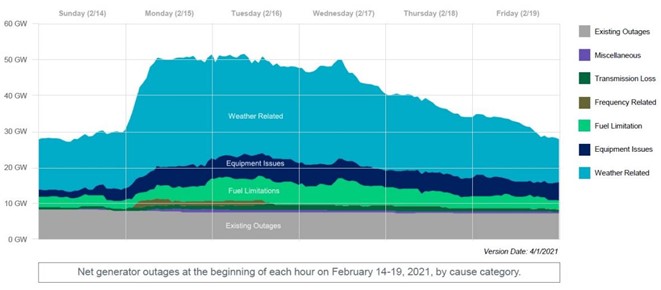Texan energy crisis: Lessons for Australian electricity markets
From 15-19 February, the US state of Texas endured a winter storm that dragged temperatures well below freezing, 20℃ or more below seasonal norms. Electricity generation plant and gas infrastructure proved unprepared for these temperatures and around a third of the state’s effective capacity went offline for some or all of this period, just as demand was spiking to a new winter record.
Figure 1: Generator outages by cause, 14-19 February (view larger image here)

Source: ERCOT
The collapse of the power system was averted only by instituting widespread load shedding, with some customers enduring power cuts for over three days. This led to several deaths and major discomfort for millions of Texans. While surrounding states also saw some power supply issues, the main Texas market (and system) ERCOT was much worse affected. This, coupled with the knowledge that a similar event had occurred only ten years previously (albeit with less severe consequences) has caused many to ask what was wrong with the ERCOT system.
Suggested culprits ranged from too many renewables to gas dependency, the energy-only market design, deregulation, and ERCOT’s lack of interconnection with neighbouring systems. Several of those system features are shared by or similar to Australia’s National Electricity Market (NEM). The West Australian market (WEM) is less similar but is another isolated grid with a similar generation mix. Accordingly, some questions have also been raised as to whether there are any lessons for the Australian electricity markets in this crisis.
The answer is that the lessons are extremely limited. Most of the features of ERCOT that have been blamed are essentially red herrings. The scale of the outages, and the fact that they largely had the same root cause (a rare extreme cold event), mean that the issue is one of failure to plan for system resilience to such weather. This is not to say that the ERCOT grid is not resilient to some threats – it rode through a major hurricane in 2017 without any need for load-shedding – but not to this type of weather, which appears to occur frequently enough to be worth planning for.
Successful planning will also require implementation of the necessary upgrades to generation plant, whether through mandatory standards or targeted incentives, noting that the main market incentive of a high price cap (US$9,000, or around A$11,790) has historically not been adequate to drive widespread winterization. To maximise plant availability, the gas sector (which has a different regulator) would also need to be more resilient to the same type of extreme weather. All of this will cost money, so either directly or indirectly, consumers will pay more. They should be clear about the likely trade-offs. These factors all mean that from a governance perspective, the drive for increased resilience should come from the state government – it will not be sufficient for individual regulators or the market operator to seek to improve resilience, albeit they are likely to be the best parties to be empowered to monitor and enforce any new resilience requirements.
NEM policymakers have devoted some resources to issues of resilience and ways to cost-effectively improve it following the lessons learned from the black system event in South Australia in 2016. There has been a recent rule change to empower the Australian Market Operator (AEMO) to plan for more high impact but low probability (HILP) events that go beyond what are normally considered credible contingencies for the power system. The WEM has also learned from the experience of the Varanus Island explosion which curtailed gas supplies, but where the electricity system managed to remain secure. At a national level, the Commonwealth has set up the Critical Infrastructure Centre and established a forum for owners and operators of energy infrastructure to share best practice on resilience. It has also created an Electricity Sector Climate information (ESCI) project to provide tailored climate information to the sector. This does not mean resilience has been “solved” for the NEM or the WEM. Notably, there is an outstanding recommendation from the Finkel review that there should be a regular (three-yearly) assessment of the NEM’s resilience to human and environmental threats. But at least Australian policymakers have an eye on these issues and have taken some reasonable steps to date to mitigate the risks.
Read the full report, Texan Energy Crisis: Lessons for Australian electricity markets
Kieran Donoghue is Director of Newgrange Consulting.
Since founding Newgrange Consulting in late 2017, Kieran has provided energy policy, advocacy and strategic communications advice to a diverse range of organisations, including the Energy Security Board, the Australian Energy Regulator, the Business Council, the Australian Energy Council, Energy Consumers Australia, Energy Networks Australia and energy industry participants in both the network and competitive sectors.
Prior to founding Newgrange, Kieran’s career included over 7 years as the energy policy lead at Australian Energy Council & the Energy Supply Association, 4 years at the British energy regulator Ofgem and over 9 years as a chartered accountant in a range of corporate and advisory roles.
Related Analysis
2025 Election: A tale of two campaigns
The election has been called and the campaigning has started in earnest. With both major parties proposing a markedly different path to deliver the energy transition and to reach net zero, we take a look at what sits beneath the big headlines and analyse how the current Labor Government is tracking towards its targets, and how a potential future Coalition Government might deliver on their commitments.
International Energy Summit: The State of the Global Energy Transition
Australian Energy Council CEO Louisa Kinnear and the Energy Networks Australia CEO and Chair, Dom van den Berg and John Cleland recently attended the International Electricity Summit. Held every 18 months, the Summit brings together leaders from across the globe to share updates on energy markets around the world and the opportunities and challenges being faced as the world collectively transitions to net zero. We take a look at what was discussed.
Retail protection reviews – A view from the frontline
The Australian Energy Regulator (AER) and the Essential Services Commission (ESC) have released separate papers to review and consult on changes to their respective regulation around payment difficulty. Many elements of the proposed changes focus on the interactions between an energy retailer’s call-centre and their hardship customers, we visited one of these call centres to understand how these frameworks are implemented in practice. Drawing on this experience, we take a look at the reviews that are underway.
Send an email with your question or comment, and include your name and a short message and we'll get back to you shortly.



